We take a tour with a local expert to discover the highlights of the Yorkshire Dales, from sleepy villages to historic castles, in one day
Words by Natasha Foges
The gentle TV series All Creatures Great and Small, chronicling the adventures of Yorkshire Dales vet, James Herriot, has been a huge hit on both sides of the Atlantic, and is set to return to our screens later this year. With its low-stakes storylines – which might include a cow with sunstroke, a dog stuck in a peat bog, or calcium-deficient sheep – the series harks back to a simpler age.
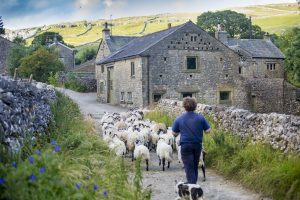
Yorkshire Dales National Park. Credit: Stephen Garnett.
But adorable animals and winsome vets notwithstanding, it’s the unspoilt, tranquil landscapes that are the real star of the show. I spent a day with Tim Barber of Real Yorkshire Tours to explore the Yorkshire Dales’ most beautiful corners, from All Creatures locations to lost-in-time villages; from majestic abbeys to ancient valleys dotted with the traces of Saxons and Vikings. To experience the highlights of the Yorkshire Dales in a day, Tim takes me to Wensleydale and Wharfedale, each of which has its own distinct identity.
An engaging and personable guide, Tim has an astonishing wealth of local knowledge. Locals don’t always agree on the number of Dales – these rolling landscapes can’t neatly be parcelled up, and counts vary from 20 to over 50 – but most of the Dales (from the Norse dalur, meaning valley) are named after the river that runs through them.
The exception – and the start of our journey – is Wensleydale, whose river is the Ure. We drive along the same winding lanes that Alf Wight (the real-life James Herriot) navigated from his home in Thirsk, often finding his way in the pitch black to an outlying farm in the heart of the Dales.
Our first stop is Masham (pronounced ‘Massam’), a quintessential Dales market town, with its little village school, pub and 16th-century weavers’ cottages arranged around a large square. As well as wool and cloth markets, a dairy market was once held here, with wares laid out on the time-worn stone steps of the medieval buttercross.
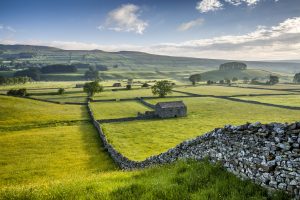
Masham is famous for its breweries and its birds. Visit in late spring to see the hundreds of swifts that flock to Masham every year; locals attach nesting boxes to their houses and there’s much competition to spot the first swift of the year. Nearby Jervaulx Abbey was founded by 13 Cistercian monks, who eked out a humble existence selling wool at the market in Masham. But within 100 years they had grown staggeringly wealthy thanks to the widely held belief that donations to the Church would speed one’s passage through Purgatory.
Dissolved under Henry VIII, the abbey stands as a romantic ruin, with wildflowers adorning its weathered stone walls and Gothic arches.
The Jervaulx monks were famous for breeding horses, a tradition that continues in the area to this day. There are 15 racing stables nearby, and the historic town of Middleham is known for training thoroughbreds. We spot some impressively glossy steeds grazing in the surrounding fields, and jockeys can often be seen strolling the cobbled streets in their colourful silks.
The 12th-century Middleham Castle, a hulking quadrangular fortress, dominates the town. It was the childhood home of King Richard III and the town holds a festival in his honour every July.

Litton in Littondale. Credit: Rebecca Cole/Alamy
We are now into limestone country, the rolling fields edged with dry stone walls and dotted with field barns and a seemingly infinite number of sheep. Appropriately enough, a sheep – the hardy, curly-horned Swaledale breed, able to leap dry stone walls and survive on the windswept moors – is the symbol of the Yorkshire Dales National Park. You can get up close to the local wildlife at the Wensleydale Experience, a working farm where visitors help with lambing in the spring, feed piglets or learn the art of dry stone walling.
Deeper into Wensleydale, we arrive at Bolton Castle, a storybook affair built in 1399 by Sir Richard le Scrope, Lord Chancellor to King Richard II, in what was then a hunting forest. In a nod to its origins, wild boar snuffle around the castle grounds.
Mary Queen of Scots was incarcerated at the castle in 1568 – though it was more a genteel house arrest than a harsh imprisonment. She arrived with 25 ladies-in-waiting, including her own cooks, hairdressers and embroiderers, and the Scrope family had to give her their best rooms.
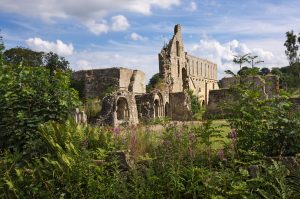
After six months of lavish hosting, the family’s joy at the news that Mary was finally to leave can only be imagined. Ascending further, the landscape becomes more remote and wildly beautiful. Holes in the cliffs in upper Wensleydale are reminders of the area’s mining past: until the end of the 19th century these rugged hills swarmed with miners, toiling underground to extract galena, used in the production of lead. While the mine owners’ profits boomed, life was hard for the workers.
It was common to see miners busily knitting as they walked miles to work, to supplement their meagre income. Many mining families lived in Askrigg (which, incidentally, stood in for the village of Darrowby in the original 1970s version of All Creatures Great and Small).
Encouraged by the mine owners, dissenting religions such as Wesleyanism and Methodism took firm root in places such as Askrigg, to keep the workers out of the pubs and boost productivity in the mines. As well as a medieval market cross and a village church, the village has a Temperance Hall, which once served refreshments to the local miners (strictly hot chocolate and cordial only).
The workaday feel can also be felt in the town of Hawes, sitting between the mountain passes of Buttertubs and Fleet Moss. First recorded as a marketplace in 1307, Hawes still holds regular cattle and sheep sales, presided over by a tweed-jacketed auctioneer. But most visitors come here to sample the world-famous Wensleydale cheese, made with creamy milk from local dairies.
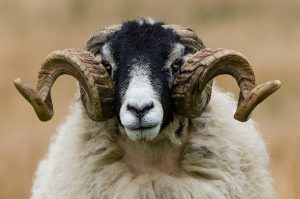
magnificent pair of curly horns. Credit: Wellwoods
Cheese-making skills were brought to the area by the Jervaulx monks, who originally made a sheep’s milk cheese. Upon the Dissolution of the Monasteries they passed their precious recipe to farmers’ wives.
The Wensleydale Creamery now ships its creamy, crumbly cheese all over the world. You can tour the creamery to watch the ancient alchemy of cheese-making in action, or simply head to the cheese shop to taste it for yourself – perhaps, as the locals do, on a slice of fruitcake.
Appetites sated, we ascend out of Wensleydale to Wharfedale, and yet more spectacular views, which sweep over limestone hills, moorland, rivers and ancient woodland down to Bolton Abbey, standing in isolated splendour on a bend of the river.
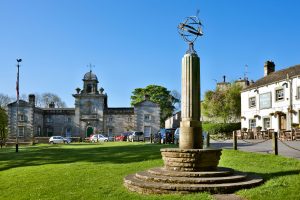
Fountaine Inn. Credit: Christina Bollen / Alamy
A string of pretty villages sit alongside the gently flowing River Wharfe. In lovely Yockenthwaite, crossed by a medieval packhorse bridge, we see ‘Helen’s farm’ from All Creatures – in reality a farm of 5th-generation sheep farmers. A single-track lane lined with wildflowers leads to the hamlet of Hubberholme, another key All Creatures location – James and Helen took their wedding vows in the 11th-century church of St Michael and All Angels. Inside the church are a rare, hand-painted rood loft, a raised platform where medieval musicians performed during services; and oak pews hand-carved by craftsman Robert Thompson (‘the Mouseman’) with a tiny mouse, his signature.
We stop at the little village of Linton for a pint of local ale at the whitewashed Fountaine Inn and sit on the village green to take in a scene of perfect rural beauty, complete with a bubbling stream, two stone bridges and an old red telephone box. Next to the inn is a curious Baroque building, which was built in the 1720s by Richard Fountaine, a local man who made his fortune in haberdashery, and who left instructions in his will for an almshouse to be built on this site to care for elderly villagers. With its ornamental cupola and Doric pilasters, the building has a grandeur unmatched anywhere in the Dales – but then, our day has been full of surprising discoveries.

Grassington stands
in for Darrowby in All
Creatures. Credit: travellinglight/Alamy
We cross a narrow bridge over the River Wharfe to reach our final stop, Grassington, which features in All Creatures as the sleepy village of Darrowby. It still looks like a film set, with bunting fluttering over the high street, an abundance of tearooms and a handsome pub, The Devonshire (whose windows still bear the name of its alter ego, the Drovers Arms).
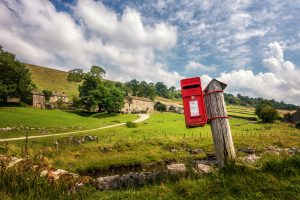
Yockenthwaite. Credit: Rebecca Cole / Alamy
Before bidding the Dales farewell I step into the Stripey Badger bookshop – the filming location for Darrowby’s grocers – and pick up a copy of All Creatures Great and Small. Having seen these beautiful landscapes up close, Herriot’s tender tales of the Dales will, I’m sure, come vividly to life.
This is an extract, read the full feature in the November/December 2023 issue of BRITAIN, available to buy here from Friday 6 October.
Read more:

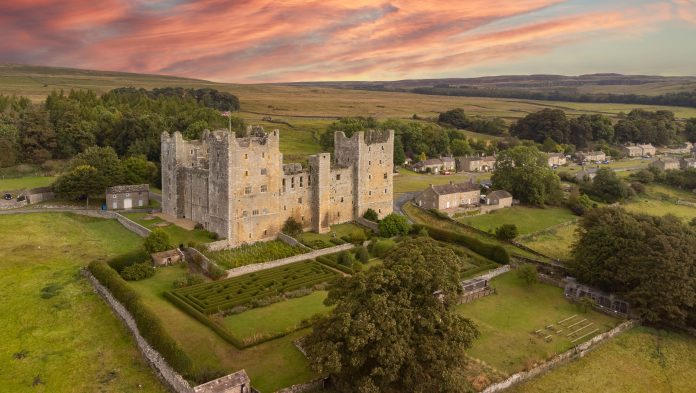




 © 2024
© 2024